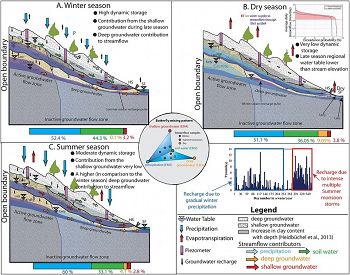Dwivedi et al., 2019
Hydrologic functioning of the deep critical zone and contributions to streamflow in a high‐elevation catchment: Testing of multiple conceptual models
Dwivedi R., Meixner T., McIntosh J.C., Ferré P.A.T., Eastoe C.J., Niu G.-Y., Minor R.L., Barron-Gafford G.A., Chorover J. (2019)
Hydrological Processes 33(4): 476-494
-
Catalina-Jemez, GRAD STUDENT
-
Catalina-Jemez, INVESTIGATOR
-
Catalina-Jemez, INVESTIGATOR
-
Catalina-Jemez, INVESTIGATOR
-
Catalina-Jemez, INVESTIGATOR, COLLABORATOR
-
Catalina-Jemez, INVESTIGATOR
-
Catalina-Jemez, INVESTIGATOR
Abstract
Endmember mixing analysis, 3H model “age,” and baseflow recession analysis results‐based interpretation of the streamflow generation processes and their seasonal characters during (a) winter season; (b) dry season; and (c) summer monsoon. The centre part of the figure shows the butterfly‐type mixing space with precipitation, soil water, deep groundwater, and shallow groundwater stores as the mixing space vertices. Note, (1) the early (blue) and late (purple) season water table locations are shown here to highlight variation in dynamic storage with season, (2) the horizontal columns in each plot show % seasonal streamflow contributions from various endmembers, and (3) the open boundary in a, b, and c conceptual models suggests intercatchment groundwater flow, which is represented by deep groundwater endmember
High‐elevation mountain catchments are often subject to large climatic and topographic gradients. Therefore, high‐density hydrogeochemical observations are needed to understand water sources to streamflow and the temporal and spatial behaviour of flow paths. These sources and flow paths vary seasonally, which dictates short‐term storage and the flux of water in the critical zone (CZ) and affect long‐term CZ evolution. This study utilizes multiyear observations of chemical compositions and water residence times from the Santa Catalina Mountains Critical Zone Observatory, Tucson, Arizona to develop and evaluate competing conceptual models of seasonal streamflow generation. These models were tested using endmember mixing analysis, baseflow recession analysis, and tritium model “ages” of various catchment water sources. A conceptual model involving four endmembers (precipitation, soil water, shallow, and deep groundwater) provided the best match to observations. On average, precipitation contributes 39–69% (55 ± 16%), soil water contributes 25–56% (41 ± 16%), shallow groundwater contributes 1–5% (3 ± 2%), and deep groundwater contributes ~0–3% (1 ± 1%) towards annual streamflow. The mixing space comprised two principal planes formed by (a) precipitation‐soil water‐deep groundwater (dry and summer monsoon season samples) and (b) precipitation‐soil water‐shallow groundwater (winter season samples). Groundwater contribution was most important during the wet winter season. During periods of high dynamic groundwater storage and increased hydrologic connectivity (i.e., spring snowmelt), stream water was more geochemically heterogeneous, that is, geochemical heterogeneity of stream water is storage‐dependent. Endmember mixing analysis and 3H model age results indicate that only 1.4 ± 0.3% of the long‐term annual precipitation becomes deep CZ groundwater flux that influences long‐term deep CZ development through both intercatchment and intracatchment deep groundwater flows.
Citation
Dwivedi R., Meixner T., McIntosh J.C., Ferré P.A.T., Eastoe C.J., Niu G.-Y., Minor R.L., Barron-Gafford G.A., Chorover J. (2019): Hydrologic functioning of the deep critical zone and contributions to streamflow in a high‐elevation catchment: Testing of multiple conceptual models. Hydrological Processes 33(4): 476-494. DOI: 10.1002/hyp.13363
 This Paper/Book acknowledges NSF CZO grant support.
This Paper/Book acknowledges NSF CZO grant support.
Explore Further








